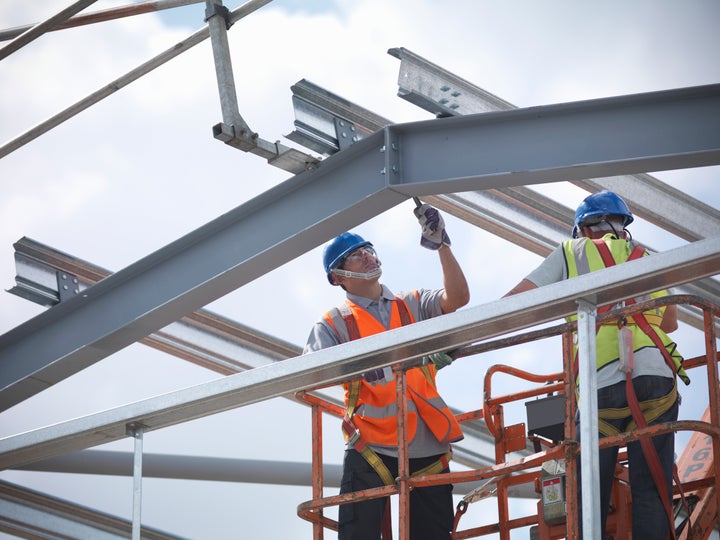Proposed reforms to planning rules could force councils to choose between affordable housing and supporting an area’s infrastructure and community spaces.
On Thursday morning the government unveiled its Planning for the Future white paper, an 80-page document detailing radical changes to the way developers apply for planning permission.
The consultation refers repeatedly to maintaining current levels of affordable housing – or improving them – and “beautiful and sustainable new homes and places”.
But changing the way developers are made to adhere to affordable housing guidelines could see the number of affordable homes plummet, and could also hit the infrastructure and environmental sustainability of the communities faced with new developments.
New rules could mean councils have the option of reducing council tax bills for existing residents instead of investing in affordable homes, further segregating communities.
What’s changing?
The warnings stem from the proposed eradication of Section 106 agreements, which are currently used to make developers build a certain amount of social homes on a site.
The government’s own document on the reforms highlights the fact that in 2018/19 Section 106 agreements were worth a total of £7bn, of which £4.7bn was in the form of affordable housing contributions – supporting the delivery of 30,000 affordable homes.
Instead of Section 106, the government wants to encourage councils to introduce an Infrastructure Levy, which would not be negotiated in the same way as a Section 106 agreement would be. Instead, the levy would be charged by the local planning authority as a fixed proportion of the development value above a certain threshold. The level of this threshold is not set out in the consultation.
What’s the problem with that?
Paul Smith, housing chief at Bristol City Council, said: “While the document talks about a system that delivers more affordable housing, it’s not actually clear what the mechanism will be for doing that.
“There’s a real concern that we will just see the planning system, which is already quite restricted in its ability to deliver affordable housing, become even more so if these reforms are implemented as they currently are.
“We’ve got 13,000 households on our waiting list. We’ve got 600 families in temporary accommodation. We’ve got 250 people living in hotels, and we’ve got 1,100 people in supported housing. We’ve got an incredible need for more social housing in the city, and these proposals will make it much more difficult to deliver that through the planning system.”
With the replacement of Section 106 and the Community Infrastructure Levy – the latter of which cannot currently be spent on affordable housing and is usually used to enhancing provisions for the community – there are concerns that an Infrastructure Levy could force councils into having to choose between building affordable housing, and making improvements to infrastructure and public space such as parks and roads.
Smith explained: “At the moment you can’t use infrastructure funding for affordable housing – it has to be for other improvements, which might be things like community facilities, environmental improvements and contributions towards schools.
“These are all things that affordable housing would then have to compete with [if they came out of the same pot], and that’s a big worry. With the Section 106 agreements that wasn’t the case.
“That current infrastructure funding is often used in consultation with local residents because it’s supposed to be about mitigating the impact of a development in an area, and so we use it for things like new crossings, parks, cycle paths and planting trees.
“Those will now be pitched directly against providing affordable housing within schemes. In some areas what you could see people saying is: ‘Well, we don’t want affordable housing – we want our town green or roads improved.’
“Instead of affordable housing being sort of privileged within the system, which it is partially at the moment, it will be pitched against these other improvements that people want to see in their communities.”
Later in the white paper, the government suggests: “We could also increase local authority flexibility, allowing them to spend receipts on their policy priorities, once core infrastructure obligations have been met. [...] This could include [...] reducing council tax.”
Reducing council tax is typically seen as a vote-winner for local authorities. HuffPost UK spoke to one senior planner who feared that pitting this against the provision of affordable homes for those on the waiting list could present a conflict of interest for councils and be “the opposite of sustainable development”.
Who’s at the sharp end of all this?
Some third sector organisations have already warned that the proposed reforms could lead to an “extinction” of badly-needed social housing, with fears that the change to regulations could prompt “slum” conditions in new development.
Tory MP Geoffrey Clifton-Brown, who represents the Cotswolds, said he was concerned about the quality of new homes which could be built under the proposals.
The veteran MP, treasurer of the backbench Conservative 1922 Committee, told BBC Radio 4’s World At One on Thursday: “We do need some reform, but as people who have tried this before have found, if you are not careful it does have knock-on effects.
“Whilst I’m all in favour of building more houses, they need to be good-quality houses, we have got to be really sure that we are not building slums of tomorrow by building today at low quality.”
He said the “devil is always in the detail” and added that he had concerns about “how much local democratic control there is going to be”.
More than a million people in the UK are on a waiting list for social homes, and could be facing an increasingly hopeless situation if Section 106 requirements are removed.
Incidentally, a separate, smaller consultation – also launched by the government on Thursday morning – suggested raising the threshold below which a developer can get away without delivering affordable homes. Currently the limit for a development with no affordable housing is 10 homes: the government could raise that to 50, a change that could see thousands of affordable properties lost every year.
While the Planning for the Future document refers a number of times to the importance of affordable housing, the second consultation simultaneously points towards slashing requirements for developers – particularly impacting new builds in overcrowded cities.
Diarmaid Ward, Islington Council’s executive member for housing and development told HuffPost UK: “This is a government that’s obsessed with the idea that if you leave everything to the free market then everything will be fine and it’s just not true.
“The government’s plans are basically just a developer’s charter. You can build anything you want anywhere, and you can entirely shirk your responsibility to build genuinely affordable homes.
“The government are obsessed with this idea that enough houses get built it will bring prices down and suddenly everyone will have somewhere to live – but it simply isn’t true.”
What does the government say?
Amid the criticism of the new development plans, the PM insisted his planning reforms will see more social housing built.
During a visit to a housing development in Warrington, he told reporters: “What we’re doing is simplifying the process so you actually get much more affordable housing.
“This solution gives them [builders] a much simpler infrastructure levy that enables them to go ahead and build a much bigger chunk of affordable housing and help people onto the property ladder.
“So I think it’s going to have the reverse effect and enable us to build more homes for lots of different types of tenure, whether that’s social rent, whether it’s part-buy part-rent, all kinds of things that will help people onto the property ladder.”
But critics of the plan have also pointed out that the reforms are concentrated on the planning system, which may not in fact be where the delays and bureaucracy associated with new housing developments are really concentrated.
Ward said: “I think fundamentally the government don’t understand what the problem is, because 90% of planning applications are approved. There’s definitely a problem with developers sitting on land once planning permission has been granted.
“If you look at the reality of house building in the UK, the last time we built 300,000 homes in a year was in the 1970s and at that stage councils built 40% of them.
“So if the government really wants cut the red tape around building then let’s cut the red tape around social housing. Let’s have a properly-funded national building programme.”
A spokesperson for MHCLG did not comment on the potential implications of affordable housing funding competing with infrastructure and community improvements, but claimed: “Our proposals will introduce a simpler levy that ensures developers deliver at least as much – if not more – affordable housing.
“We will speed up the process for building affordable housing and local infrastructure, as over 80% of councils agree the current system of developer contributions causes delay.
“To speed up construction where development has been approved, we propose making clear in the revised National Planning Policy Framework that the masterplans and design codes for sites prepared for substantial development should include a variety of development types from different builders which allow more phases to come forward together.”


